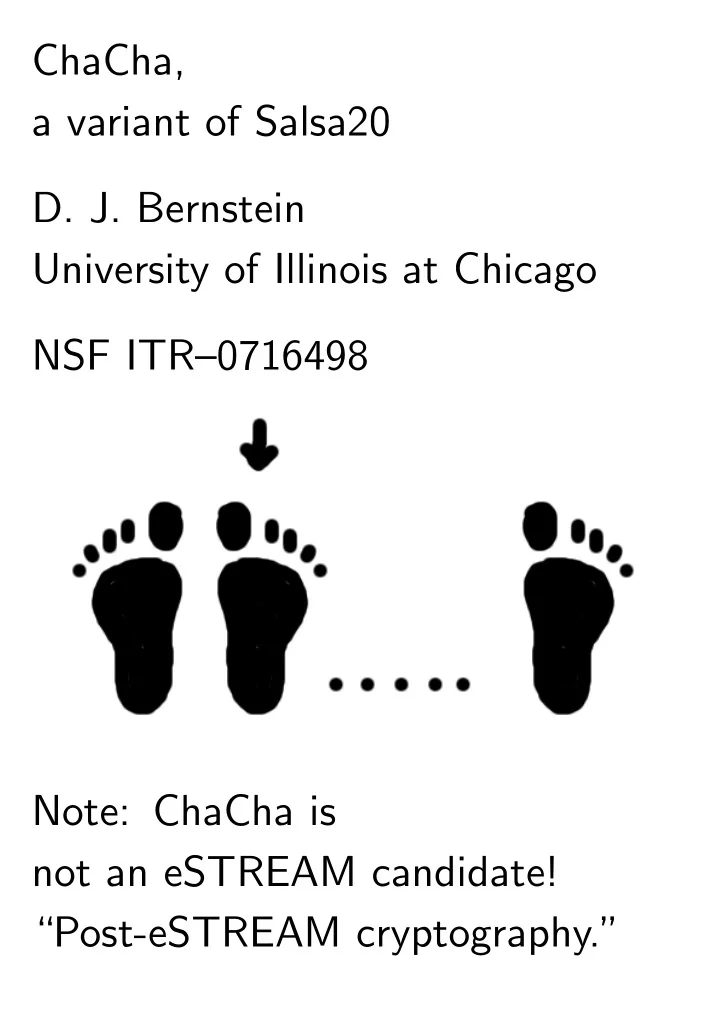

ChaCha, a variant of Salsa20 D. J. Bernstein University of Illinois at Chicago NSF ITR–0716498 Note: ChaCha is not an eSTREAM candidate! “Post-eSTREAM cryptography.”
The Salsa20 cipher family Salsa20/20 is faster than AES. I recommend Salsa20/20 as an AES replacement for typical applications. What if the users value speed more highly than confidence? Reduce rounds: Salsa20/12 or /8. Attacks: Crowley, SASC 2006; Fischer et al., Indocrypt 2006; Tsunoo et al., SASC 2007; Aumasson et al., FSE 2008. Against Salsa20/8, slightly faster than 256-bit exhaustive search.
The ChaCha cipher family ChaCha8, ChaCha12, ChaCha20 are like Salsa20/8 etc.: same key size, same block size, same arithmetic operations. But there are some changes in the order of operations. Aumasson et al. attack a preliminary “ChaCha” with one of these changes. The change makes the attack fail one round sooner. Perhaps the other changes are also helpful. Need analysis!
Changed order of operations often saves some CPU time. Cycles/byte, 576-byte packet, for ChaCha8 and Salsa20/8: C8 S8 2.00 2.14 ppc32 PowerPC G4 2.09 2.07 amd64 Core 2 Duo 3.47 3.66 amd64 Athlon 64 X2 4.06 5.57 amd64 Pentium D f64 5.05 5.54 x86 Pentium M 695 6.11 5.98 x86 Pentium 4 f12 6.27 7.06 x86 Pentium 4 f41 6.71 6.76 sparc UltraSPARC III 7.02 7.20 ppc64 Cell PPE
Salsa20 quarter-round 4 modifications per quarter-round: x4 ^= (x0+x12) <<< 7 x8 ^= (x4+x0) <<< 9 x12 ^= (x8+x4) <<< 13 x0 ^= (x12+x8) <<< 18 16 modifications per round. 128 modifications in Salsa20/8. 320 modifications in Salsa20/20. Key words kept separate? No! (“I also see each use of a k word as a missed opportunity to spread changes through the n words.”) Constants kept separate? No!
ChaCha quarter-round Salsa20 temporarily allocates separate word for storing sum. Missed diffusion opportunity! ChaCha takes this opportunity: x0+=x12; x4^=x0; x4<<<=16 x8+=x4; x12^=x8; x12<<<=12 x0+=x12; x4^=x0; x4<<<=8 x8+=x4; x12^=x8; x12<<<=7 In absence of carries, average 1-bit differential affects 12.5 output bits. Salsa20: only 8 output bits.
Salsa20 round switch Salsa20 sweeps down columns: x4 , x8 , x12 , x0 ; x9 , x13 , x1 , x5 ; x14 , x2 , x6 , x10 ; x3 , x7 , x11 , x15 . Then across rows: x1 , x2 , x3 , x0 ; x6 , x7 , x4 , x5 ; x11 , x8 , x9 , x10 ; x12 , x13 , x14 , x15 . Modifications in these two rounds: below-diagonal, : : : , : : : , diagonal, : : : , : : : , below-diagonal, diagonal.
ChaCha round switch ChaCha sweeps up columns: x0 , x12 , x8 , x4 ; x5 , x1 , x13 , x9 ; x10 , x6 , x2 , x14 ; x15 , x11 , x7 , x3 . Then across rows: x0 , x1 , x2 , x3 ; x5 , x6 , x7 , x4 ; x10 , x11 , x8 , x9 ; x15 , x12 , x13 , x14 . Diagonal, : : : , : : : , below-diagonal, diagonal, : : : , : : : , below-diagonal. Intuition: better diffusion.
Salsa20 input positions Only 128 bits of input are controlled by attacker: x6 , x7 , x8 , x9 . 2 256 possible input pairs. ı 2 264 possible state pairs. Wishful-thinking differentials impose ı 512 bit conditions and will never be entered. See “Salsa20 security,” 2005.04. Successful reduced-round attacks have traced 1-bit differential starting from “best” bit in x6 , x7 , x8 , x9 .
ChaCha input positions New choice of input positions: x1 , x6 , x11 , x12 . All of these words are modified at second position in quarter-round. Intuition: less variability in “goodness” of these bits; “best” bit for ChaCha isn’t as good as “best” bit for Salsa20. Also: Output array is permuted. Better speed; identical security. Convenient to describe states with the same permutation. See paper for details.
Recommend
More recommend